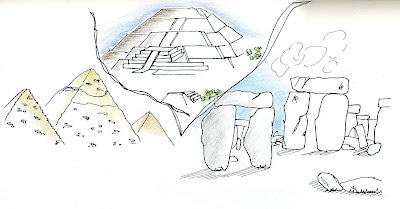
idiom: region, culture, and context all influence the styles that designers use. egyptians used sandstone in their architecture because they were surrounded by sand. carvings of religious artifacts reflected their highly religious way of life. as we journey through the iarc program, the goal is for us to create our own idiom and style of work. as designers work, they develop a characteristic style that reflects their personality, time period, or region. their style manifests in their work.

 materials: the context of a design impacts the materials. in turn, materials influence and sometimes limit the design. prehistoric civilizations used stones, wood, mud brick, and animal skins to build because these materials were readily available. many used naturally occurring negative space in the form of caves, such as at ajunta, india (roth 61). designing a combination chair/table/server out of mdf also presents challenges because we only had a 4’ x 8’ sheet of ¾” mdf. when planning the design, we had to be creative to create the maximum work area with the minimum material. designers must adapt and respond appropriately to the material available.
materials: the context of a design impacts the materials. in turn, materials influence and sometimes limit the design. prehistoric civilizations used stones, wood, mud brick, and animal skins to build because these materials were readily available. many used naturally occurring negative space in the form of caves, such as at ajunta, india (roth 61). designing a combination chair/table/server out of mdf also presents challenges because we only had a 4’ x 8’ sheet of ¾” mdf. when planning the design, we had to be creative to create the maximum work area with the minimum material. designers must adapt and respond appropriately to the material available. illuminate: throughout classes, we talked about ways to emphasize specific areas through contrast. every design has aspects that are more important or ideas that are being conveyed. one way to illuminate is through light. according to louis kahn, “there is no true architecture without natural light” (roth 85). in ancient Egypt, the sun was important because of its regularity and the sun god ra. when designing the pyramids at giza, the white limestone finish and gold peak were intended to direct sunlight in the four cardinal directions and to make the pyramids gleam and shine. using light to direct attention can also be seen in the ecstasy of st. theresa, with hidden natural light and golden rods illuminating the area (roth 86). i use watercolors to highlight an area of a drawing. when constructing designs, we think about the important parts of the designs and how to showcase those elements.
illuminate: throughout classes, we talked about ways to emphasize specific areas through contrast. every design has aspects that are more important or ideas that are being conveyed. one way to illuminate is through light. according to louis kahn, “there is no true architecture without natural light” (roth 85). in ancient Egypt, the sun was important because of its regularity and the sun god ra. when designing the pyramids at giza, the white limestone finish and gold peak were intended to direct sunlight in the four cardinal directions and to make the pyramids gleam and shine. using light to direct attention can also be seen in the ecstasy of st. theresa, with hidden natural light and golden rods illuminating the area (roth 86). i use watercolors to highlight an area of a drawing. when constructing designs, we think about the important parts of the designs and how to showcase those elements.
commoditie. firmness. delight: sir henry wotten says that “well-building hath three conditions: commoditie, firmeness, and delight” (roth 11). when constructing a design, we must think about how the work fulfills all these conditions in a cohesive manner. my design for pat’s chair satisfies these, with an emphasis being on commoditie. i also created a pair of earrings inspired by a fairytale. their function was to convey the essence of my story in a non-literal way. they were structurally sound and pleasing to the eye. the problem with delight is that it involves subjective responses that differ between individuals and cultures (roth 67). what is aesthetically pleasing in one culture may not be viewed the same way in another. the appearance of a work is determined by the creator’s background and cultural background.
a lot of thought and planning goes into a design. all of these elements discussed are things the influence or limit designs. bringing these things together makes a cohesive, well-rounded product.
No comments:
Post a Comment